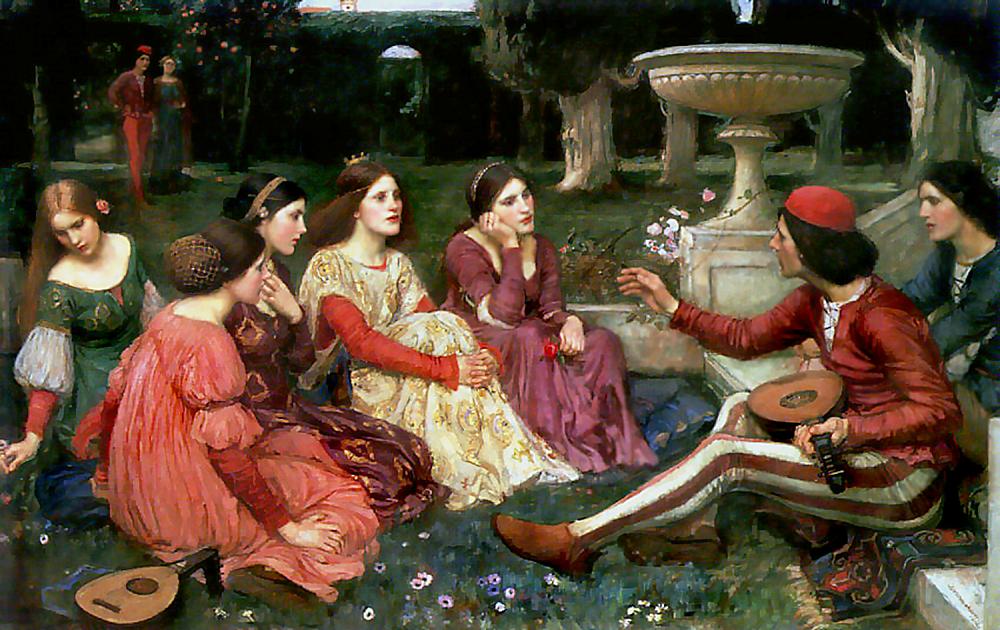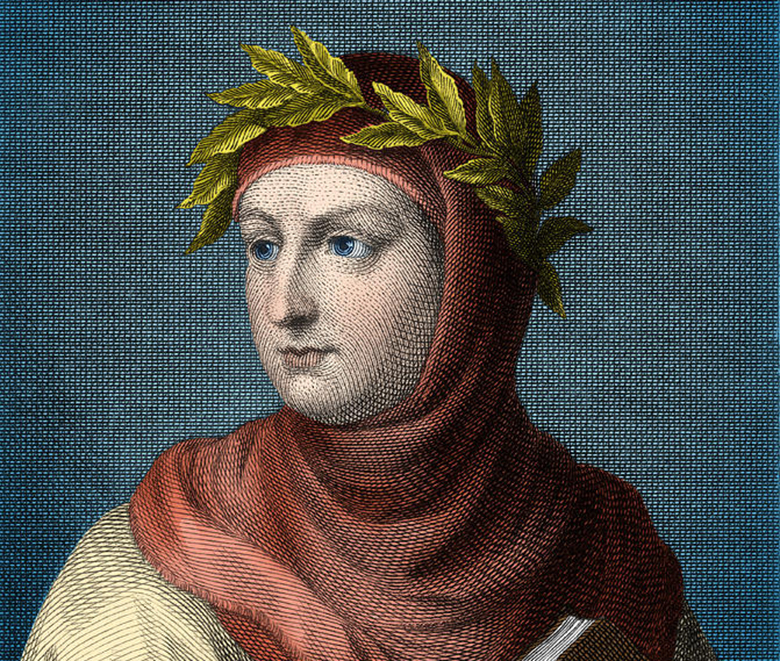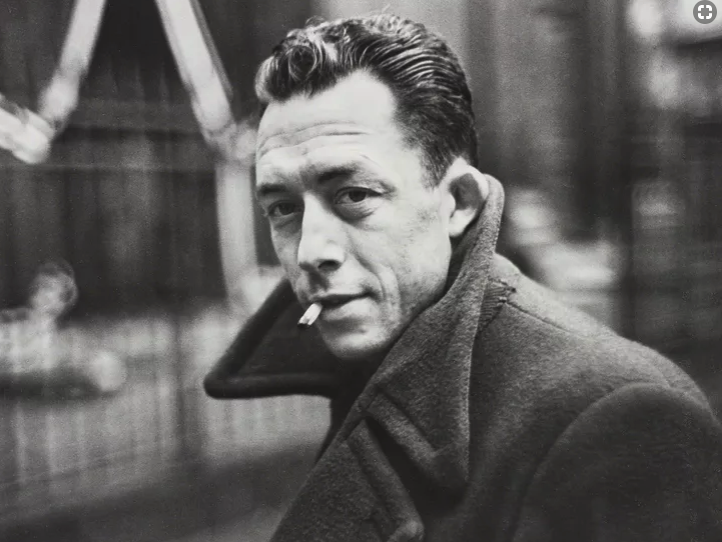by Fraser Hibbitt
In Albert Camus’ The Plague (1947), the narrator comments that ‘there have been as many plagues as wars in history; yet always plagues and wars take people equally by surprise’. Camus’ novel, itself indebted to an amalgam of literature dealing with the plague, attests to another kind of surprise – that writing on the plague still retains novelty. If plague and pestilence, despite their recurrent nature, can be considered as indefatigably new, it is only because it recalls something unresolved. If we consider Boccaccio’s The Decameron (c. 1353), this something becomes evident. Boccaccio’s work is set against the backdrop of a Florence which has been subsumed by the Black Death. In fact, it is only by fleeing the stricken-city that the narrators of The Decameron can recite their tales; death and societal strife are concealed from view in order to reveal the vast tapestry of narratives which Boccaccio weaves. This unresolved something is, of course, humanity’s understanding of their existential position; the existential scope that arises from the tension between life and death, between societal calamity and prosperity. Boccaccio’s oppositional setting enforces this clear distinction; we have, as The Decameron has been nicknamed, the ‘human comedy’ versus the very inhuman crisis of Florence, and Florence here is symbolic of any inflicted city. This oppositional tension is the hallmark characteristic of plague literature and it is fitting that it is so clearly demarcated in the first notable piece of literature that grapples with the plague theme.

John William Waterhouse’s The Decameron
As I have said, it is the telling of tales that the ten narrators of The Decameron busy themselves with while waiting out the plague. Over the course of the book, there are a hundred stories recited. Whereas in Florence, there is only one tale to tell – that of death and suffering. The plague itself imposes a strict narrative structure: one is infected, suffers greatly with a slim chance of survival. In other words, it is a narrative of human life without moral or intellectual meaning; the mortal frame to which humanity is bound. The tales of Boccaccio, however, are, as the epithet ‘human comedy’ suggests, a rich array of human morality and intellectual worth. It is this subtle tension between morality and mortality that plague literature so forcibly symbolizes by engaging with the very thing – pestilence – that negates all human pretension. In writing these tales, Boccaccio is effectively calling our attention to the fact that there is more to life than the bodily disintegration which humanity cannot escape.
Writing on the plague is, then, to compete with the narrative of the plague. The narrative which the plague imposes is that bland, nevertheless terrifying, truism that all born must meet death – albeit, here, in an excruciating and hastened manner. The plague narrative offers this meaning as the only meaning of life, yet it is with plague literature that we find a scouring for meaning in between the two necessities of birth and death. Boccaccio’s tales, his representation of this search for meaning, are finely delineated from the plague’s narrative by place and time, thus serving as a wonderfully compact way of viewing the antagonism between these two narratives of meaning. In his use of moralistic tales to counter the narrative of the plague, Boccaccio is interrogating his social milieu; he is saying: ‘yes, we die, but what does it mean to live?’. What it means to live, and how to go about living, are unresolved queries. This is why plague literature upholds such an inexhaustible store of symbolic use.
Boccaccio seemed to have envisioned the plague as purely a symbol of death, and therefore a perfect counterpoint to his tales. He does not have anything to say on the origin of a certain pestilence because it is of no use to him. The plague narrative, however, can be endowed with meaning beyond that of death. For example, when God sends a plague in the Old Testament, we are well aware of the meaning: it is just punishment. However, when Thucydides writes of the pestilence that struck Athens during the Peloponnesian war, he notes how the suppliants at the temples died along with the rest. Between divine intervention and Thucydides exists another human reaction to pestilence which is that of ‘sense-making’. Divine intervention is explicit: ‘life must be in accordance with my will’. Thucydides, with his aim of objectivity, is beginning the long journey of reason to re-write the narrative of the plague into something comprehensible, something more than the mysterious wave of death and hysteria sent from the heavens.

Boccaccio
Divine intervention and the strict line of reason amount to an idea of containment. If pestilence can be contained, it can be dealt with and understood. It may not take away the virulency, but to embody pestilence with meaning, a trajectory, a representation, serves to dampen the aura around the visitation. This is, perhaps, why, in light of the scientific revolution, plague literature veered away from the unifying vision of Boccaccio to a complex mixture of Thucydidean objectivity and divine logic in facing pestilence. In the early eighteenth century, Daniel Defoe published his A Journal of the Plague Year (1720). A fictional historical account of the plague which broke out in London in 1665. Defoe decides to base his account on a ‘surviving’ diary of one of his relatives who stayed in London during the outbreak. His curiosity forces him to survey the streets of London to relate the grim drama of the visitation, a curiosity Boccaccio never had. Here is the obvious difference between the two: Boccaccio’s narrators are commenting from afar whilst H.F., the individualist narrator of the journal, goes in search of these tales. Defoe’s medley of tales is not so much a unifying vision but a plenty of competing narratives vying against the plague. The narrator reprimands the pervasive quackery; discusses possible scientific explanation; gives his thoughts on how the plague should have been handled; and, finally, is careful to distinguish between good moral behavior and the reprehensible, sordid actions taken by individuals during the visitation. It is all very comprehensible, and, besides the affirmation of religious faith, modern.
It is clear by the eighteenth century, plague literature is not only using the plague to navigate and represent the ‘human comedy’, but is seeking to contain and make sense of the unwelcome visitation. After all, writing about the plague is a way of controlling, of codifying, and managing its virulency. There is no longer any clear distinction between life and death, but the confrontation between the two. Defoe ends his fictional narrative with affirmation of faith. He cannot comprehend why the plague retreated after ravishing London for a year; all the narratives fall flat to the reason of its coming and its departure; death can only be described, not overcome. The inability to understand this unjustified death, the sudden outbreak as well as the transience of the plague, becomes a symbolic representation of humanity’s existential condition in Albert Camus’ The Plague. Camus managed the plague to explore the meaningless struggle with death that living engenders. Largely informed by his thought on the absurd and humanity’s duty to create value, The Plague epitomizes Camus’s vision to face the senseless calamity with a collected and, in this way, a limited scope. There is no searching for causes and meaning, there is only the recognition of the hopeless state and the creation of value through solidarity. It is, for Camus, humanity against death; the collective integrity of ordinary people to cast aside explanation and any other belief but that of saving human life.

The iconic photo of Albert Camus by Henri Cartier-Bresson
Writing in a time of the holocaust and the rationalized terror of Communist Russia, it becomes clear why Camus’s passionate cry for human life becomes the defining melody through the regrettable harmony of pestilential death. Camus felt that confrontation with the plague, this absurdity of living, could be the bind humanity needed, offering the opportunity for humanity to create their own meaning – and, more importantly, to re-establish the bond between humanity. It is with Camus that we recognize the long-drawn conclusion from plague literature. It is that, strangely, like love, pestilence reminds us of a kind of openness. By its tenacious grip on human life and value, pestilence reveals what it is in humanity that is worth living for. It is this openness which Camus wants to elicit – in fact, it is the reason why the book is written. The narrator tells the old tale after he has lived through the events and decides to set down the chronicle of the plague not because of its dramatic nature, but to remind the reader ‘that there are more things to admire in men than to despise’.
Despite the modern capability to understand pestilence, the enduring symbol of pestilence within the canon of plague literature attests to the demand to understand the complexity of living at any given time in history. Boccaccio’s unity still stands as the faithful representation of pestilence: humanity ever poised between life and death; the searching to make sense of pestilence does not quell this fundamental issue. Yet the transformations that plague literature has journeyed through speaks of a more dynamic relationship to these absolutes. Boccaccio’s narrators have something of the divine about them and it does not come as a surprise when much criticism speaks of them as allegorical figures. Defoe’s narrator, H.F., has something miraculous about him too. The individual who walks through the plagued streets somehow managing to avoid the clusters of death on all sides. Upon reaching Camus, we find the hardship of ordinary men and women – a somewhat atheistic reconciliation between Boccaccio’s stark distinction between life and death, and Defoe’s complex drama of the city inflicted. The narrator, Dr. Rieux, survives; his wife and closest companion do not. All he can admit is his duty to human life. It is by no coercion that sanitation squads come together to help administer vaccines, it is by their conscience and love of life. That, as Camus’ plague reminds us, must be the first value on which human relationships depend before the job of navigating existence can begin.
==========
The Carl Kruse blog home page is here.
Contact: carl AT carlkruse DOT com
Other articles by Fraser Hibbitt include The Case for Dreams, Stoicism, and Google Glass.
The blog’s last article was Variations of Beauty and the Beast.
Find Carl Kruse on ClearVoice.
A super timely article. I’m re-reading The Plague these days. I guess many are.
Thanks for your kind words and for stopping by Akiko.
Carl Kruse
Yes indeed. Timely. Many thanks.
Thank you Teifion.
Carl Kruse